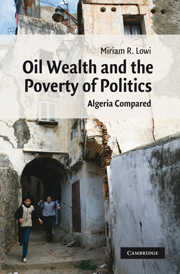Book contents
- Frontmatter
- Contents
- List of tables
- List of figures
- Preface
- Map of Algeria
- Part I Introduction
- 1 Oil shocks and the challenge to states
- 2 Natural resources and political instability
- Part II Algeria and its discontents
- Part III Comparisons and conclusions
- 8 Conclusions: oil wealth and the poverty of politics
- Bibliography
- Index
- CAMBRIDGE MIDDLE EAST STUDIES 32
1 - Oil shocks and the challenge to states
Published online by Cambridge University Press: 29 March 2010
- Frontmatter
- Contents
- List of tables
- List of figures
- Preface
- Map of Algeria
- Part I Introduction
- 1 Oil shocks and the challenge to states
- 2 Natural resources and political instability
- Part II Algeria and its discontents
- Part III Comparisons and conclusions
- 8 Conclusions: oil wealth and the poverty of politics
- Bibliography
- Index
- CAMBRIDGE MIDDLE EAST STUDIES 32
Summary
In the mid-1970s, after the first oil shock, Algeria had the highest growth rate (8.5 percent) of all oil-exporting late developing countries (LDC). It was touted as one of the most successful experiments in economic development and one of the most politically stable oil exporters. Algeria was hailed as a model revolutionary, post-colonial state: having brought to an end 130 years of French settler colonialism after a seven-year long war of national liberation, and faced with mass exodus of the European population with their expertise and capital, the leadership of the newly independent state embarked upon broad programs of reconstruction and development. In the first decades, and especially under President Houari Boumedienne, social and economic policies suggested a commitment to development with social justice. With burgeoning oil revenues, enormous efforts were made at rapid industrialization, building up infrastructure, and educating the population – roughly 80 percent of whom were illiterate at independence.
By 1982, however, world demand for oil was declining. Demand for OPEC oil was declining even more as increased output from Mexico and the North Sea cut into OPEC's share of a shrinking market. Oil prices fell from their peak of close to $40/barrel in 1980. Then in 1986, and largely in response to the increase in Saudi production to keep up with the market force of new producers, the price of oil collapsed – to less than $10/barrel. During this same period, the value of the dollar, the currency in which hydrocarbons are traded, declined as well.
- Type
- Chapter
- Information
- Oil Wealth and the Poverty of PoliticsAlgeria Compared, pp. 3 - 26Publisher: Cambridge University PressPrint publication year: 2009

